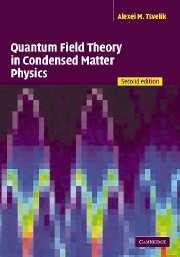Book contents
- Frontmatter
- Contents
- Preface to the first edition
- Preface to the second edition
- Acknowledgements for the first edition
- Acknowledgements for the second edition
- I Introduction to methods
- II Fermions
- III Strongly fluctuating spin systems
- IV Physics in the world of one spatial dimension
- Introduction
- 22 Model of the free bosonic massless scalar field
- 23 Relevant and irrelevant fields
- 24 Kosterlitz–Thouless transition
- 25 Conformal symmetry
- 26 Virasoro algebra
- 27 Differential equations for the correlation functions
- 28 Ising model
- 29 One-dimensional spinless fermions: Tomonaga–Luttinger liquid
- 30 One-dimensional fermions with spin: spin-charge separation
- 31 Kac–Moody algebras: Wess–Zumino–Novikov–Witten model
- 32 Wess–Zumino–Novikov–Witten model in the Lagrangian form: non-Abelian bosonization
- 33 Semiclassical approach to Wess–Zumino–Novikov–Witten models
- 34 Integrable models: dynamical mass generation
- 35 A comparative study of dynamical mass generation in one and three dimensions
- 36 One-dimensional spin liquids: spin ladder and spin S = 1 Heisenberg chain
- 37 Kondo chain
- 38 Gauge fixing in non-Abelian theories: (1 + 1)-dimensional quantum chromodynamics
- Select bibliography
- Index
Introduction
Published online by Cambridge University Press: 05 May 2010
- Frontmatter
- Contents
- Preface to the first edition
- Preface to the second edition
- Acknowledgements for the first edition
- Acknowledgements for the second edition
- I Introduction to methods
- II Fermions
- III Strongly fluctuating spin systems
- IV Physics in the world of one spatial dimension
- Introduction
- 22 Model of the free bosonic massless scalar field
- 23 Relevant and irrelevant fields
- 24 Kosterlitz–Thouless transition
- 25 Conformal symmetry
- 26 Virasoro algebra
- 27 Differential equations for the correlation functions
- 28 Ising model
- 29 One-dimensional spinless fermions: Tomonaga–Luttinger liquid
- 30 One-dimensional fermions with spin: spin-charge separation
- 31 Kac–Moody algebras: Wess–Zumino–Novikov–Witten model
- 32 Wess–Zumino–Novikov–Witten model in the Lagrangian form: non-Abelian bosonization
- 33 Semiclassical approach to Wess–Zumino–Novikov–Witten models
- 34 Integrable models: dynamical mass generation
- 35 A comparative study of dynamical mass generation in one and three dimensions
- 36 One-dimensional spin liquids: spin ladder and spin S = 1 Heisenberg chain
- 37 Kondo chain
- 38 Gauge fixing in non-Abelian theories: (1 + 1)-dimensional quantum chromodynamics
- Select bibliography
- Index
Summary
This part of the book is fully devoted to the physics of (1 + 1)-dimensional quantum or twodimensional classical models. As usual, I shall distinguish between classical and quantum systems only if it is necessary. Those models where the difference between quantum and classical is not relevant will be called ‘two-dimensional’; those where for some reason or other I want to emphasize the quantum aspect will be called ‘one-dimensional’.
The reason I spend so much time discussing two-dimensional physics is that here one finds a kind of paradise for strong interactions and nonperturbative effects. Those effects which are tricky or even impossible to achieve in higher dimensions appear in almost every two-dimensional model. To our greatest satisfaction there are theoretical tools at our disposal which allow us to solve many of the corresponding problems and describe these phenomena. The availability of these strong mathematical tools is a unique feature of two-dimensional physics. Even if it turns out to be impossible to generalize these tools for higher dimensions, I hope that the reader will be rewarded for the time spent by the pleasure obtained from contemplating their beauty.
The world we are about to enter has certain distinct features which are worth mentioning in the introduction. The first one concerns the second-order phase transitions. In (1 + 1)-dimensional systems such transitions may occur only at zero temperature.
- Type
- Chapter
- Information
- Quantum Field Theory in Condensed Matter Physics , pp. 197 - 198Publisher: Cambridge University PressPrint publication year: 2003

